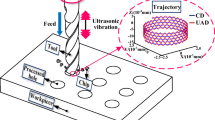Abstract
Conventional drilling (CD) which is known by two constant rotary and linear motions causes some problems in drilling of materials such as high thrust force, poor surface quality, and rapid tool wear. To get rid of these problems or at least minimize them, a promising technology has been employed in the recent years, where vibrations usually with low amplitude and high frequency are applied to the direction of feed motion results in a time-dependent velocity between drill tip and workpiece. This paper focuses on the design of a vibratory tool following by experimental and numerical approaches to study the influence of longitudinal ultrasonic vibrations on drilling of aluminum alloy 7075. Experimental part is a comprehensive exercise to design, fabricate, and test a system equipped with different instruments to work in desired conditions. Experimental results are supported by a finite element method to better comprehend what is happening in cutting process when ultrasonic vibrations are added. The achieved results prove that using ultrasonic-assisted drilling (UAD), the machining ability of drilled aluminum workpiece can enhance significantly. Improvement of up to 40% for drill circularity and a reduction of up to 37% in thrust force were achieved.
Similar content being viewed by others
References
Amini S, Paktinat H, Barani A, Tehrani AF (2013) Vibration drilling of Al2024-T6. Mater Manuf Process 28:476–480
Barani A, Amini S, Paktinat H, Tehrani AF (2014) Built-up edge investigation in vibration drilling of Al2024-T6. Ultrasonics 54:1300–1310
Makhdum F, Phadnis VA, Roy A, Silberschmidt VV (2014) Effect of ultrasonically-assisted drilling on carbon-fibre-reinforced plastics. J Sound Vib 333:5939–5952
Kadivar M, Akbari J, Yousefi R, Rahi A, Nick MG (2014) Investigating the effects of vibration method on ultrasonic-assisted drilling of Al/SiCp metal matrix composites. Robot Comput Integr Manuf 30:344–350
Li X, Meadows A, Babitsky V, Parkin R (2015) Experimental analysis on autoresonant control of ultrasonically assisted drilling. Mechatronics 29:57–66
Sanda A, Arriola I, Navas VG, Bengoetxea I, Gonzalo O (2016) Ultrasonically assisted drilling of carbon fibre reinforced plastics and Ti6Al4V. J Manuf Process 22:169–176
Alavi SH, Harimkar SP (2015) Melt expulsion during ultrasonic vibration-assisted laser surface processing of austenitic stainless steel. Ultrasonics 59:21–30
Alavi SH, Harimkar SP (2016) Evolution of geometric and quality features during ultrasonic vibration-assisted continuous wave laser surface drilling. J Mater Process Technol 232:52–62
Mitrofanov A, Babitsky V, Silberschmidt VV (2003) Finite element simulations of ultrasonically assisted turning. Comput Mater Sci 28:645–653
Mitrofanov A, Babitsky V, Silberschmidt VV (2004) Finite element analysis of ultrasonically assisted turning of Inconel 718. J Mater Process Technol 153:233–239
Mitrofanov A, Babitsky V, Silberschmidt VV (2005) Thermomechanical finite element simulations of ultrasonically assisted turning. Comput Mater Sci 32:463–471
Amini S, Soleimanimehr H, Nategh M, Abudollah A, Sadeghi M (2008) FEM analysis of ultrasonic-vibration-assisted turning and the vibratory tool. J Mater Process Technol 201:43–47
Patil S, Joshi S, Tewari A, Joshi SS (2014) Modelling and simulation of effect of ultrasonic vibrations on machining of Ti6Al4V. Ultrasonics 54:694–705
Khajehzadeh M, Razfar MR (2015) FEM and experimental investigation of cutting force during UAT using multicoated inserts. Mater Manuf Process 30:858–867
Amini S, Nazari MM, Rezaei A (2015) Bending vibrational tool for friction stir welding process. Int J Adv Manuf Technol 84(9):1889–1896
Karimi A, Amini S (2016) Steel 7225 surface ultrafine structure and improvement of its mechanical properties using surface nanocrystallization technology by ultrasonic impact. Int J Adv Manuf Technol 83:1127–1134
Johnson GR, Cook WH (1983) A constitutive model and data for metals subjected to large strains, high strain rates and high temperatures. In Proceedings of the 7th International Symposium on Ballistics: 541–547
Nemat-Nasser S, Amini M, Choi J, Isaacs J (2007) Experimental and computational evaluation of compressive response of single and hex-arrayed aluminum tubes. J Mech Mater Struct 2:1901–1920
Chen DC, You CS, Gao FY (2014) Analysis and experiment of 7075 aluminum alloy tensile test. Procedia Engineering 81:1252–1258
Ceretti E, Lucchi M, Altan T (1999) FEM simulation of orthogonal cutting: serrated chip formation. J Mater Process Technol 95:17–26
Arrazola PJ (2010) Investigations on the effects of friction modeling in finite element simulation of machining. Int J Mech Sci 52:31–42
Amini S, Kazemiyoun M (2014) Effect of ultrasonic vibrations on chip–tool contact zone in turning of AISI304. Mater Manuf Process 29:627–633
Chang SS, Bone GM (2009) Thrust force model for vibration-assisted drilling of aluminum 6061-T6. Int J Mach Tools Manuf 49:1070–1076
Oliaei SNB, Karpat Y (2016) Investigating the influence of built-up edge on forces and surface roughness in micro scale orthogonal machining of titanium alloy Ti6Al4V. J Mater Process Technol 235:28–40
Gómez-Parra A, Álvarez-Alcón M, Salguero J, Batista M, Marcos M (2013) Analysis of the evolution of the built-up edge and built-up layer formation mechanisms in the dry turning of aeronautical aluminium alloys. Wear 302:1209–1218
Wang Z, Kovvuri V, Araujo A, Bacci M, Hung W, Bukkapatnam S (2016) Built-up-edge effects on surface deterioration in micromilling processes. J Manuf Process 24(2):321–327
Shaw MC 2005, Metal cutting principles vol. 2: Oxford university press New York, 2005
Groover MP 2007, Fundamentals of modern manufacturing: materials processes, and systems: John Wiley & Sons
Kalpakjian S 2001, Manufacturing engineering and technology: Pearson Education India
Author information
Authors and Affiliations
Corresponding author
Rights and permissions
About this article
Cite this article
Paktinat, H., Amini, S. Ultrasonic assistance in drilling: FEM analysis and experimental approaches. Int J Adv Manuf Technol 92, 2653–2665 (2017). https://doi.org/10.1007/s00170-017-0285-2
Received:
Accepted:
Published:
Issue Date:
DOI: https://doi.org/10.1007/s00170-017-0285-2



